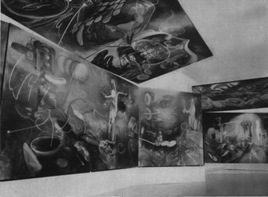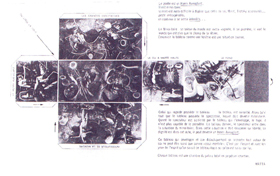A visionary and rebel, Matta considered that the artist’s role in society was to trouble consciences. This was an uncomfortable situation for his immediate circle, which rejected him and turned him into an honni aveuglant or “dazzling outcast”; into “a character that exists in stories and in all sorts of situations,” as Matta wrote in 1965, “hated but at the same time indispensable. For example Marat in the French Revolution or Trotsky in the Russian Revolution. They were individuals who continued to dazzle even though they were excluded”.
“Like the little boy in Andersen’s tale, who was the only one to say that the king had no clothes”, Matta continues, the artist must assume his role of being rejected but at the same time dazzling. Through his work he must ensure that the viewer “rather than possessing the painting is possessed by it, bombarded from all sides by a vast amount of conscience”.
Following various experiments with “open cubes” that were “spatial projections of his subconscious”, in 1966 Matta created the cycle L’Honni aveuglant. He finally gave form to his great project to represent an individual’s overall growth through a “system of analogies, a poetic system”. The six sides of the cube each represent one of the viewer’s environments. One side is the earth with all its elements. On the opposite side is the cosmos. Another canvas represents the future with its degree of unpredictability and surprise, in contrast to the past, which appears on another side. The two remaining sides respectively depict hostile forces and sympathetic ones.
At the centre of the cube is the viewer, surrounded by friends and enemies, by cultural inheritance and expectations and constantly aware that he/she is located between the earth and the sky. Matta thus achieves his ultimate aim of ensuring that anyone who saw his work will be “trapped in an unbearable situation because of that painting, [...] the viewer also obliged to undertake a poetic act of creation in order to make it his own: besieged by the real, he feels defeated and thus reflects”.
The invitation to the original presentation of Matta’s cycle at the Iolas Gallery,where the works were shown soon after their completion, shows the six sides of the cube opened out like a paper cut-out. The canvas entitled L’Honni aveuglant (The Dazzling Outcast) represents the alliance of positive forces, in turn symbolizing the redemptive role of the artist. It contrasts with Le Où à marée haute (The Where at High Tide), which represents the forces that threaten us. Les Grandes expectatives (Great Expectations) offers an analogy of the future, while Interrupteur de la memoire (Memory Switch) connects us to the past. Finally, the two paintings of Où loge la folie A et B (Where Madness Dwells A and B) symbolise the earth in contrast to Le Fond (The Background), which represents the sky.
-
- L'honni Aveuglant exhibition invitation, Paris, June-July 1966
- Tipo:
- Iolas Gallery
-

-
- L'Honni Aveuglant installation, Paris, June-July 1966
- Tipo:
- Iolas Gallery
As can be seen in the photographs of the cycle’s installation in Paris, the cube was ultimately not completely closed, consisting of four sides that opened to let the viewer in. This change was probably due to the practical impossibility of translating his concept into real space, although it may have been intentional and Matta possibly aimed to break away from the Euclidian cube, opening up its angles and creating orthogonals that extended into infinity. Whatever the case, when Baron Thyssen-Bornemisza acquired these works in 1974, shortly after they were exhibited in an exhibition on Matta in Ferrara, the cycle L’Honni aveuglant only consisted of five canvases shown on four sides of the cube.
The Museum is now inviting visitors to immerse themselves in Matta’s universe, experiencing the idea that in front of these canvases we respectively encounter our future (with Les Grandes expectatives), the forces of nature over our heads (Où loge la folie A et B), and menacing dangers on the right (Le Où à marée haute). On the left, between the coloured shapes of L’Honni aveuglant that represent our allies, we may be able to perceive Matta ready to help us and above all to reveal a new reality to us.

